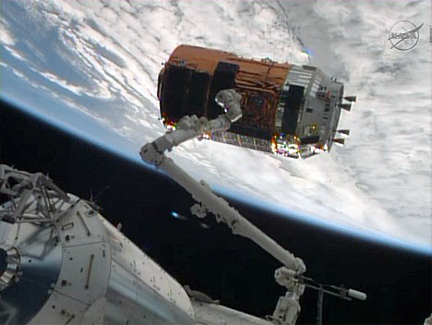Japanese HTV cargo ship attached to space station
08/09/2013 12:36 PM Filed in: Space News | International Space Station
By WILLIAM HARWOOD
CBS News
A Japanese cargo ship loaded with nearly 4 tons of science gear, supplies and spare parts pulled to within about 30 feet of the International Space Station Friday and stood by while astronaut Karen Nyberg, operating the station's robot arm, locked onto a grapple fixture to complete a smooth automated rendezvous.
Launched last Saturday from the Tanegashima Space Center in southern Japan, the HTV-4 cargo ship, known as "Kounotori," or "white stork," was captured by the robot arm at 7:22 a.m. EDT (GMT-4) as the two spacecraft passed just south of South Africa.
"Houston, station, capture's complete," Nyberg called. "We'd like to say congratulations to the entire JAXA (Japan Aerospace Exploration Agency) team and everybody else around the world who has successfully gotten the fourth HTV to the International Space Station."
"And Karen and the rest of the Expedition 36 crew, congratulations," astronaut Mike Fincke replied from mission control. "Down here, we show a successful grapple and capture of the Kounotori cargo vehicle. Good work."
With the visiting spacecraft safely in hand, Nyberg, working at a robotics work station in the multi-window cupola compartment, handed off control of the robot arm to flight controllers at the Johnson Space Center.
The ground team then maneuvered the cargo ship to the Earth-facing port of the station's forward Harmony module. After getting the common berthing mechanisms properly aligned, motorized bolts were driven home in two stages to lock the craft in place. The work was completed at 11:38 a.m.
Developed by the Japan Aerospace Exploration Agency as a contribution to the space station program, the HTV is designed to carry both pressurized and unpressurized cargo, including equipment too big to pass through the space station's hatches.
For its fourth flight to the International Space Station, the pressurized section of HTV-4 was carrying an experiment sample freezer, spacesuit oxygen tanks, batteries, a spare spacewalk jet backpack and a variety of crew supplies, including food, clothing and fresh water.
The pressurized section also carried a high-resolution camera that will be used to image Comet ISON and four small Cubesat satellites that will be deployed from the Japanese Kibo laboratory's airlock.
The HTV's unpressurized section carried a main bus switching unit, part of the station's electrical power distribution system, a spare solar array power and data interface unit and a NASA experiment pallet housing eight research projects in a variety of disciplines.
The astronauts plan to open hatches between Harmony and the HTV on Saturday to being the process of unloading the supplies and hardware stowed in the supply ship's pressurized section. The station's robot arm will swing into action Sunday to begin the job of extracting and moving the unpressurized components to external storage platforms.
If all goes well, the HTV-4 spacecraft, reloaded with trash and no-longer-needed equipment, will be detached from the station Sept. 4, burning up in the atmosphere a few days later.
CBS News
A Japanese cargo ship loaded with nearly 4 tons of science gear, supplies and spare parts pulled to within about 30 feet of the International Space Station Friday and stood by while astronaut Karen Nyberg, operating the station's robot arm, locked onto a grapple fixture to complete a smooth automated rendezvous.
Launched last Saturday from the Tanegashima Space Center in southern Japan, the HTV-4 cargo ship, known as "Kounotori," or "white stork," was captured by the robot arm at 7:22 a.m. EDT (GMT-4) as the two spacecraft passed just south of South Africa.
 |
| A Japanese HTC cargo ship loaded with nearly 4 tons of supplies and equipment stands by Friday while the International Space Station's robot arm moves in for grappling. The cargo craft then was attached to the station's forward Harmony module. (Photo: NASA TV) |
"And Karen and the rest of the Expedition 36 crew, congratulations," astronaut Mike Fincke replied from mission control. "Down here, we show a successful grapple and capture of the Kounotori cargo vehicle. Good work."
With the visiting spacecraft safely in hand, Nyberg, working at a robotics work station in the multi-window cupola compartment, handed off control of the robot arm to flight controllers at the Johnson Space Center.
The ground team then maneuvered the cargo ship to the Earth-facing port of the station's forward Harmony module. After getting the common berthing mechanisms properly aligned, motorized bolts were driven home in two stages to lock the craft in place. The work was completed at 11:38 a.m.
Developed by the Japan Aerospace Exploration Agency as a contribution to the space station program, the HTV is designed to carry both pressurized and unpressurized cargo, including equipment too big to pass through the space station's hatches.
For its fourth flight to the International Space Station, the pressurized section of HTV-4 was carrying an experiment sample freezer, spacesuit oxygen tanks, batteries, a spare spacewalk jet backpack and a variety of crew supplies, including food, clothing and fresh water.
The pressurized section also carried a high-resolution camera that will be used to image Comet ISON and four small Cubesat satellites that will be deployed from the Japanese Kibo laboratory's airlock.
The HTV's unpressurized section carried a main bus switching unit, part of the station's electrical power distribution system, a spare solar array power and data interface unit and a NASA experiment pallet housing eight research projects in a variety of disciplines.
The astronauts plan to open hatches between Harmony and the HTV on Saturday to being the process of unloading the supplies and hardware stowed in the supply ship's pressurized section. The station's robot arm will swing into action Sunday to begin the job of extracting and moving the unpressurized components to external storage platforms.
If all goes well, the HTV-4 spacecraft, reloaded with trash and no-longer-needed equipment, will be detached from the station Sept. 4, burning up in the atmosphere a few days later.